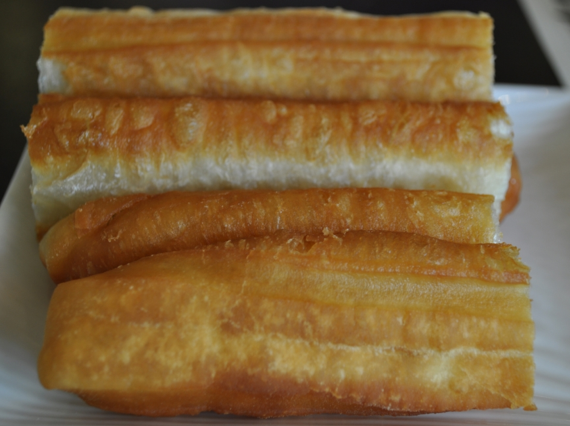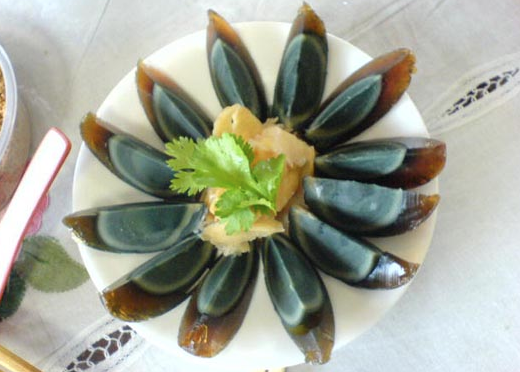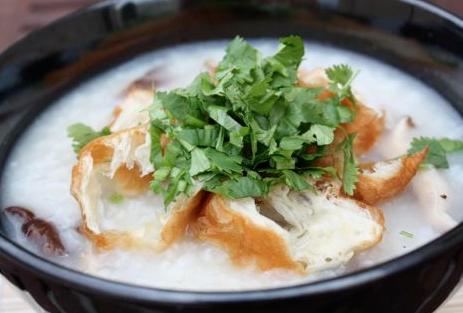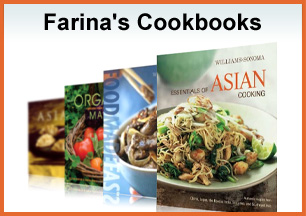The Perfect Anecdote After a Big Holiday Meal
After a week of 3 Thanksgiving dinners, all I want to eat is a big crunchy salad or a steaming bowl of congee. A basic rice porridge, congee is made by simmering grains of rice and copious amounts of water or broth until a thick rice soup forms. Considered to be food therapy in our family, congee or jook in Cantonese, is the epitome of detox comfort food.

congee or jook
A staple in most Asian cultures, congee historically was gruel that was served during times of famine as a way to stretch the supply of rice or other grains like barley or millet. Though due to it’s therapeutic qualities, it’s also the ideal meal for infants or when your feeling under the weather. Congee is commonly eaten for breakfast or a late supper. When cooked with minimal seasoning, the porridge is commonly eaten with savory side dishes and toppings. Porridges flavored with meat or seafood and other seasonings are typically served as a one-dish meal.

You Tiao – fried savory breadsticks
The range of ingredients used in preparing congee are endless and also vary with geographic origin. In China, congees are typically flavored with chicken, pork, fish and seasoned with ginger and green onions and cilantro. In Japan, porridges are flavored with mushroom, scallops and shrimp, while in Korea the rice soup is enhanced with sugar, dates and pin nuts. Even dairy products, coconut milk and various spices are incorporated into the porridge in regions of India.
My family typically makes jook with the stock made from pork, chicken or fish, simmering bits or meat in the porridge. To recuperate from my turkey hangover, I prepared a tasty broth from our Thanksgiving turkey bones and cooked a large pot of jook. I served it with my favorite toppings of sliced you tiao (fried savory breadsticks), pai dan, thousand year old eggs (preserved duck eggs), pickled ginger and lots of green onions and cilantro.

Pai Dan – preserved duck eggs
One of the simplest dishes to prepare, congee is best simmered in a large soup pot or in a rice cooker. White or brown short or long grain rice may be used with the ratio of 1 : 7 of rice to water. Before cooking, I rinse the grains of rice until the water runs clear and then swirl the rice in the bottom of the pot with 1 teaspoon of vegetable oil before adding water. This gives the congee a creamy consistency, which is typical of Cantonese style porridge. The rice is simmered over low heat for 3 to 4 hours or until the rice disintegrates and the porridge becomes thick and glossy. If you prefer a thinner consistency, just add more water or broth.
So remember to add congee to your cooking repertoire…it’s a simple cure-all dish that is always satisfying.

Cantonese style congee
Congee – Rice Porridge
Makes 4 – 6 servings
1 cup short or long grain white rice (jasmine)
1/4 cup white glutinous rice
1 teaspoon oil
1/4 teaspoon salt
7 to 8 cups water or poultry, pork or fish broth
Garnishing
1/3 cup green onions, thinly sliced across the bias
1/2 cup cilantro leaves
1/4 cup chopped peanuts
3 tablespoons finely slivered ginger
light soy sauce to taste
sesame oil to taste
ground white pepper to taste
Rinse the long grain and glutinous rice in a large bowl and rinse with cold water until the water runs clear. Place the rice in a large pot with a non-stick surface and add 1 teaspoon of oil and use your hand to swirl the rice around in the bottom of the pan. Once the oil coats the rice, add the water or broth and bring the rice to a boil over high heat.
Once the rice comes to a boil, cover the pot partially with a lid to allow the steam to escape. Reduce the heat to low and simmer the rice for 3 to 4 hours or until the rice disintegrates and the soup becomes thick and creamy. Stir the congee several times during the cooking process and add more water or broth if the soup is too thick.
Meanwhile, prepare the garnishing and place in small bowls or a platter. Serve the congee hot in deep bowls with the garnishing and condiments for seasoning.




I really enjoyed reading this! Can’t wait to try the recipe.